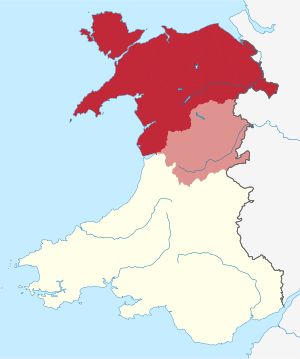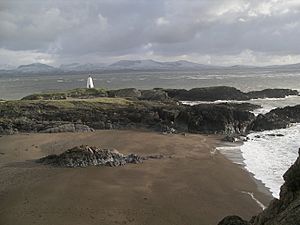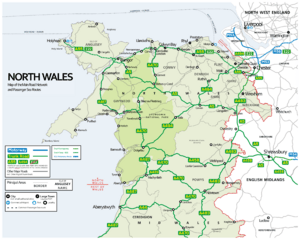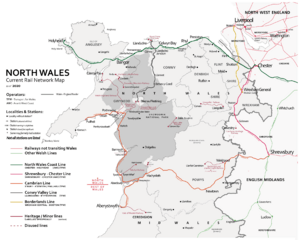North Wales facts for kids
Quick facts for kids
North Wales
Gogledd Cymru
North of Wales, Northern Wales, Y Gogledd
|
|
|---|---|
|
Geographic region
|
|

Historical extent of North Wales (red and lighter red), Montgomeryshire (lighter red) is sometimes also considered Mid Wales. Other cultural definitions of North Wales vary.
|
|

Six principal areas of Wales commonly defined to be North Wales, for policing, fire and rescue, health and regional economy.
|
|
| Sovereign state | |
| Constituent country | |
| Historic counties |
List
|
| Principal areas |
List
Isle of Anglesey
Conwy County Borough Denbighshire Flintshire Gwynedd Wrexham County Borough (historically parts of Powys) |
| Preserved counties | |
| Localities | |
| Area | |
| • Land | 6,172 km2 (2,383 sq mi) |
| Population | |
| • Estimate (2018) | 698,400 |
| • Density | 113.6/km2 (294/sq mi) |
| Demonym(s) | North Welsh, North Walian, "gogs" (informally) |
| Time zone | UTC±0 (GMT) |
| • Summer (DST) | UTC+1 (BST) |
| Postcode |
LL, CH, SY
|
North Wales (called Gogledd Cymru in Welsh) is a beautiful region in the northern part of Wales. It shares borders with Mid Wales to the south and England to the east. The Irish Sea lies to its north and west. This area is very mountainous and mostly rural. It includes Snowdonia National Park, known for its stunning mountains, waterfalls, and walking trails.
Most people live in the north-east and along the northern coast. Many people in the western and rural areas speak Welsh. North Wales doesn't have one exact boundary or government structure. It's often defined by its six northern areas, but other definitions exist. People from North Wales are sometimes called "Gogs," which comes from the Welsh word for "north."
The region is home to several towns and cities. These include Wrexham, Deeside, Rhyl, Colwyn Bay, Flint, Bangor, Llandudno, and Holyhead. Wrexham is the largest city. Bangor and St Asaph are also cities. Bangor is the oldest city in Wales, while St Asaph is one of the smallest. Wrexham became a city in 2022.
Contents
History of North Wales
For much of its history, North Wales was known as Gwynedd. This name comes from one of the last independent Welsh kingdoms. Because of this history, people in North West Wales often feel a strong Welsh identity and speak the Welsh language.
North Wales has a rich history, especially during the Middle Ages. From the 5th to the 13th centuries, powerful Welsh kingdoms like Gwynedd and Powys ruled here. They took over after the Roman Empire left Britain. The Kingdom of Gwynedd controlled most of what is now North Wales. Its rulers called themselves "Kings of the Britons."
The mountainous area of Snowdonia was the heart of Gwynedd. It was the last part of independent Medieval Wales to fall. Edward I of England conquered it in 1283. Even today, Snowdonia is a strong center for the Welsh language and culture.
World Heritage Sites in North Wales
North Wales is home to three of Wales' four UNESCO World Heritage Sites. These are special places recognized for their global importance.
- The Pontcysyllte Aqueduct and Canal is an amazing waterway built high above a valley.
- The Slate Landscape of Northwest Wales shows how important slate mining was to the area.
- The Castles and Town Walls of King Edward in Gwynedd are a group of impressive medieval castles. These include Caernarfon Castle, Beaumaris Castle, Conwy Castle, and Harlech Castle.
North Wales also shares the only UNESCO Biosphere reserve in Wales, called Biosffer Dyfi Biosphere. This area promotes living in a way that protects nature and helps people.
Defining North Wales
The exact borders of North Wales are not always clear. Different organizations might define it slightly differently. However, for official purposes, North Wales usually includes six main areas: Isle of Anglesey, Conwy, Denbighshire, Flintshire, Gwynedd, and Wrexham.
These six areas had about 698,400 people living in them in 2018. This region borders Ceredigion and Powys in Wales to the south. To the east, it borders the English counties of Shropshire and Cheshire. The Irish Sea is to the north and west. Historically, Montgomeryshire was sometimes considered part of North Wales, but today it's usually seen as part of Mid Wales.
Local Areas in North Wales
For local government, North Wales is made up of six main areas. These are counties and county boroughs:
- Isle of Anglesey
- Conwy County Borough
- Denbighshire
- Flintshire
- Gwynedd
- Wrexham County Borough
These areas are sometimes grouped into two parts for news and tourism:
- North East Wales (Denbighshire, Flintshire, Wrexham)
- North West Wales (Anglesey, Conwy, Gwynedd)
| Principal area | Created | Population | Population density/km2 |
Area (km2) |
Style |
|---|---|---|---|---|---|
| Flintshire | 1996 | 154,100 | 352 | 438 | County |
| Wrexham | 1996 | 136,600 | 271 | 498 | County borough |
| Gwynedd | 1974 | 122,900 | 48 | 2,535 | County |
| Conwy | 1996 | 116,200 | 103 | 1,130 | County borough |
| Denbighshire | 1996 | 94,700 | 113 | 844 | County |
| Isle of Anglesey | 1996 | 70,000 | 98 | 714 | County |
|
North Wales
|
2021
|
703,361 | 114.2 | 6,159 | North Wales (common definition) |
Historical Divisions
Before the current areas, North Wales had older divisions called historic counties. These included Anglesey, Caernarfonshire, Denbighshire, Flintshire, Merionethshire, and Montgomeryshire.
Geography of North Wales
North Wales is mostly rural with many mountains and valleys. Its coastline along the Irish Sea makes tourism a very important industry. Farming used to be the main activity, but it's less important now.
The eastern part of North Wales is the most populated. Over 300,000 people live around Wrexham and Deeside. Wrexham is the largest city in North Wales, with about 65,692 people in 2011. The total population of North Wales was about 696,300 in 2017. Many other towns are along the coast, like Rhyl, Llandudno, and Prestatyn.
North Wales has two cathedral cities: Bangor and St. Asaph. It also has many medieval castles, such as Harlech, Caernarfon, Beaumaris, and Conwy. The area of North Wales is about 6,172 square kilometers. This makes it a bit larger than the country of Brunei.
The highest mountain in Wales, Snowdon (Yr Wyddfa in Welsh), is located in North West Wales.
Transport in North Wales
Roads in North Wales
North Wales does not have any motorways. The closest ones are in England. Roads in North Wales are managed by the North and Mid Wales Trunk Road Agent.
Most main roads in North Wales run from east to west, especially along the coast. This is because of the mountains in the middle of Wales. This means it's often easier to travel between North Wales and North West England (like Liverpool and Manchester) than to South Wales.
The busiest road is the A55, also called the "North Wales Expressway." It's a major road connecting Chester to Holyhead along the coast. It passes through Deeside, Conwy, and Bangor. The A55 is very important for the economy of North Wales. It connects to the Port of Holyhead, where ferries go to the Republic of Ireland.
The A5 is another important historical road. It used to be the main link between North Wales and London. It crosses the famous Menai Suspension Bridge.
Sea Travel
The Port of Holyhead on Anglesey is the main port in North Wales. It handles a lot of cargo and passengers. In 2018, it was the third busiest port in Wales for freight. It's the main connection for freight and passengers traveling between Wales and the Republic of Ireland. Over 2 million passengers use it each year.
The main ferry route from Holyhead goes to Dublin Port in Ireland. This route has seen an increase in passengers over the years.
Rail Transport in North Wales
The public rail network in North Wales is mainly split into two east-west sections. There are no north-south railway lines entirely within the region. This is because of the mountains in Snowdonia and fewer passengers on north-south routes. Many older railway lines were closed down, especially during the Beeching cuts.
Most trains in Wales are operated by Transport for Wales Rail, a company owned by the Welsh Government. Some services to London are run by Avanti West Coast.
In 2017-18, about 1.4 million train journeys were made in the six main areas of North Wales. Gwynedd had the most journeys. As of 2020, there are 66 train stations in these areas. Two of the busiest stations in Wales are in North Wales: Rhyl and Bangor.
There are five main train routes in North Wales:
- The North Wales Coast Line (main line along the coast)
- The Shrewsbury—Chester Line
- The Conwy Valley Line
- The Borderlands Line
- The Cambrian Line (which also serves Mid Wales)
These lines connect North Wales to major cities like Chester, Liverpool, Manchester, and Shrewsbury. Shrewsbury is a key connection point for trains going to the Midlands and South Wales.
|
|
Heritage Railways in North Wales
North Wales has many heritage railways, which are old train lines preserved for fun and history. Most of them are narrow-gauge, meaning their tracks are narrower than standard ones. These railways employ over 300 people and bring in more than £50 million each year to the economy.
Here are some of the heritage railways in the region:
| Name | Location | Gauge | Length | Description |
|---|---|---|---|---|
| Bala Lake Railway | Bala (Penybont) to Llanuwchllyn | 600 mm (1 ft 11 5⁄8 in) | 4.5 miles (7.2 km) | Opened as the standard gauge Ruabon–Barmouth line in 1859, closed in 1948. Re-opened starting in 1966. |
| Corris Railway | Corris | 2 ft 3 in (686 mm) | 1.5 miles (2.4 km) | Opened in 1859, closed in 1948. Re-opened starting in 1966. |
| Fairbourne Railway | Fairbourne to Barmouth Ferry | 12 1⁄4 in (311 mm) | 2 miles (3.2 km) | Opened in 1916, closed in 1940. Re-opened in 1947. |
| Ffestiniog Railway | Porthmadog to Blaenau Ffestiniog | 1 ft 11 1⁄2 in (597 mm) | 13.5 miles (21.7 km) | Opened in 1836, closed in 1946. Re-opened in stages between 1956 and 1981. |
| Llanberis Lake Railway | Llanberis | 1 ft 11 1⁄2 in (597 mm) | 2.5 miles (4.0 km) | Opened in 1971 on part of the trackbed of the Padarn Railway. |
| Llangollen Railway | Llangollen to Corwen | 4 ft 8 1⁄2 in (1,435 mm) | 10 miles (16 km) | Opened in 1865, closed in 1962. Re-opened in stages between 1972 and 2015. |
| Snowdon Mountain Railway | Llanberis to Snowdon summit | 800 mm (2 ft 7 1⁄2 in) | 4.7 miles (7.6 km) | Opened in 1896. Britain's only rack railway |
| Welsh Highland Railway | Porthmadog to Caernarfon | 1 ft 11 1⁄2 in (597 mm) | 25 miles (40 km) | Opened in 1922, closed in 1937. Re-opened in stages between 1997 and 2011. |
| Welsh Highland Heritage Railway | Porthmadog | 1 ft 11 1⁄2 in (597 mm) | 1 mile (1.6 km) | Opened in 1980. |
| Welshpool and Llanfair Light Railway | Welshpool to Llanfair Caereinion | 2 ft 6 in (762 mm) | 8 miles (13 km) | Opened in 1903, closed in 1956. Re-opened in stages between 1963 and 1981. |
Tramways
In Llandudno, the Great Orme Tramway takes visitors up the Great Orme headland. It is the only cable-operated street tramway left in Great Britain.
Geology of North Wales
North Wales has a very interesting and varied geology. It has ancient rocks called Precambrian schists near the Menai Strait. There's also a large Cambrian dome under much of western Snowdonia. During the Ordovician period, volcanoes added many minerals and rocks to the north-western parts of Gwynedd. To the east of the River Conwy, you'll find rolling hills made of Silurian mudstones.
In places like Llangollen, Halkyn Mountain, and eastern Anglesey, there are beds of limestone. Metals have been mined from these areas since before Roman times. The unique rocks and minerals, like Jasper and Mona Marble, make North Wales a special place for geologists to study.
People and Language
People from North Wales are called North Welsh or North Walians. Informally, they are sometimes called "Gogs," which comes from the Welsh word Gogledd meaning "north." Most people in North Wales consider themselves "Welsh." Some also identify as "British."
Population in North Wales
In 2018, the estimated population of North Wales was 698,400 people. The population is spread out across the six main areas. Four of these areas have over 100,000 residents: Flintshire, Wrexham, Gwynedd, and Conwy. Flintshire is the most populated area, with about 155,600 people. The Isle of Anglesey is the least populated, with about 70,000 people.
North Wales has about 113.6 people per square kilometer. Flintshire is the most crowded area, while Gwynedd is the least. The population of North Wales grew by 6.3% between 1998 and 2018.
North Wales has an ageing population. The number of residents over 65 has increased, while the number of people under 15 has decreased.
Welsh Language in North Wales
North Wales has its own unique dialect of the Welsh language. It's different from the Welsh spoken in South Wales. For example, people in North Wales say llefrith for "milk," while in South Wales they say llaeth. A person from North Wales who speaks with this dialect is often called a Gog.
There are many Welsh medium schools across North Wales. These schools teach subjects in Welsh.
According to the 2011 census, over 204,400 people aged three and over in North Wales could speak Welsh. Gwynedd has the highest percentage of Welsh speakers in Wales, with 75.6% of its residents speaking Welsh. Flintshire has the lowest rate in North Wales, with 22.5% speaking Welsh. Overall, North Wales is the most Welsh-speaking region in Wales. About 41.9% of its population spoke Welsh in 2019.
Education in North Wales
North Wales is home to two universities: Bangor University and Wrexham Glyndŵr University. In 2018-19, about 17,500 students were enrolled in higher education courses here. Bangor University had most of these students.
Further education (FE) in Wales is provided by colleges. In North Wales, there are two main "super colleges":
- Grŵp Llandrillo Menai: This college serves students in Anglesey, Conwy, Denbighshire, and Gwynedd.
- Coleg Cambria: This college serves students in Denbighshire, Flintshire, and Wrexham.
These colleges offer courses for students after secondary school. Some secondary schools also have their own sixth forms for older students.
Economy of North Wales
The North Wales region has a strong economy. In 2018, the unemployment rate for people aged 16 and over was 3.9%. The employment rate was 75.9%.
North Wales Growth Deal
In 2016, the UK Government asked North Wales to propose a "Growth Deal." This deal aims to create jobs, boost the economy, improve transport, and support tourism. The North Wales Business Council, made up of local leaders and universities, prepared a plan.
Both the UK Government and the Welsh Government have promised to invest £120 million each into this Growth Deal. This funding will help develop the region and create new opportunities.
Local Media
Newspapers
Two daily newspapers are published in North Wales. The Daily Post covers the whole region. The Leader focuses on Wrexham and Flintshire.
There are also several weekly newspapers that provide local news for different communities:
- Caernarfon and Denbigh Herald
- The Mail (Bangor/Anglesey and Holyhead/Anglesey editions)
- North Wales Weekly News
- Denbighshire Free Press
- Flintshire Standard
- The Journal (Rhyl, Prestatyn and Abergele editions)
- North Wales Chronicle
- North Wales Pioneer
A weekly Welsh-language newspaper, Y Cymro, is also published. Many local community papers, called Papurau Bro, are published monthly.
Online News
Several websites provide local news online. These include Wrexham.com, which covers Wrexham, and Deeside.com, which covers the Deeside area.
Radio
North Wales is covered by national radio stations like BBC Radio Wales and BBC Radio Cymru. There are also commercial radio stations such as Capital North West and Wales and Heart North Wales. Capital Cymru broadcasts mostly in Welsh.
Community radio stations like Calon FM (Wrexham), Tudno FM (Llandudno), and Môn FM (Anglesey) serve local areas.
Television
News about North Wales is shown on BBC's Wales Today and ITV's ITV News Cymru Wales. Welsh-language news is available on S4C's Newyddion. BBC and ITV have news teams in Bangor, Wrexham, and Colwyn Bay.
Sports in North Wales
Football
Wrexham A.F.C. is a famous football club in North Wales. They play in the English football league system. In 2020, Hollywood actors Rob McElhenney and Ryan Reynolds bought the club. Their home ground is the Racecourse Ground in Wrexham.
Other teams like Connah's Quay Nomads F.C. and Bangor City F.C. play in the Welsh leagues. Many people in North Wales also support English football clubs like Liverpool F.C. and Manchester United F.C..
Rugby League
The North Wales Crusaders play in the RFL League 1, which is part of the British rugby league system. They play their games in Wrexham. North Wales also has its own amateur rugby league, the North Wales Championship.
Rugby Union
The Welsh Rugby Union created a rugby team called RGC 1404 in North Wales. The goal was to help grow the sport in the area and find more players for the Welsh national team.
Images for kids
See also
 In Spanish: Gales del Norte para niños
In Spanish: Gales del Norte para niños






